How Munro Partners finds sustainable growth stocks
Successful investing is unashamedly a game of few winners and many losers. It’s about zeroing in on individual companies that demonstrate an ability to grow profits consistently.
Equity investing isn’t about identifying the economic conditions but is about finding the big structural changes that are about to occur and the winners from these.
Pointing to the US market as an example, of the more than 25,000 companies that were listed in a 90-year period, the entire wealth of the market is concentrated among just 4% of this total.
And if you look at just the top 50 companies of that 4%, they make up almost 50% of the entire wealth of the US stock market over that period.
At Munro Partners, our job is to try and work out what's coming next. We do this by narrowing down a global universe of around 35,000 listed companies into a more manageable collection of around 1,000 names. This list is then sifted further into six areas where we believe there’s a greater likelihood of structural growth:
- Innovative health
- Climate
- Digital enterprise
- Emerging consumer
- Digital payments
- High-performance computing.
In the following video, I also discuss a handful of companies from these areas that we believe have the right characteristics to achieve the structural growth we're looking for.
Edited Transcript Below
Hi, my name's Nick Griffin. I'm the CIO here at Munro Partners, and today we're here to talk to you about the Munro Concentrated Global Growth.


At Munro Partners, we run three funds. Most people know us for the Munro Global Growth Fund, that's actually our absolute return global growth fund. Today we’re talking about the MUNRO CONCENTRATED GLOBAL GROWTH FUND, which is our long-only global growth fund, and we also run the Munro Climate Leaders Fund.
All three of our funds are designed to fit the growth hole in your portfolio. The fund I’m focusing on today is suitable for clients on a longer time horizon and is more volatile than our flagship product.
So our philosophy here at Munro Partners is fairly simple. We think that earnings growth drives stock processes. We generally find that companies that make more money every year also see their share prices rise consistently.
Secondly, we think sustained earnings growth is worth more than cyclical earnings growth, and the market often misprices growth in its sustainability. So, what we're showing you here is two companies. The first one on the right-hand side is Bank of America (NASDAQ: BAC), and the second one on the left is MasterCard (NASDAQ: MA).
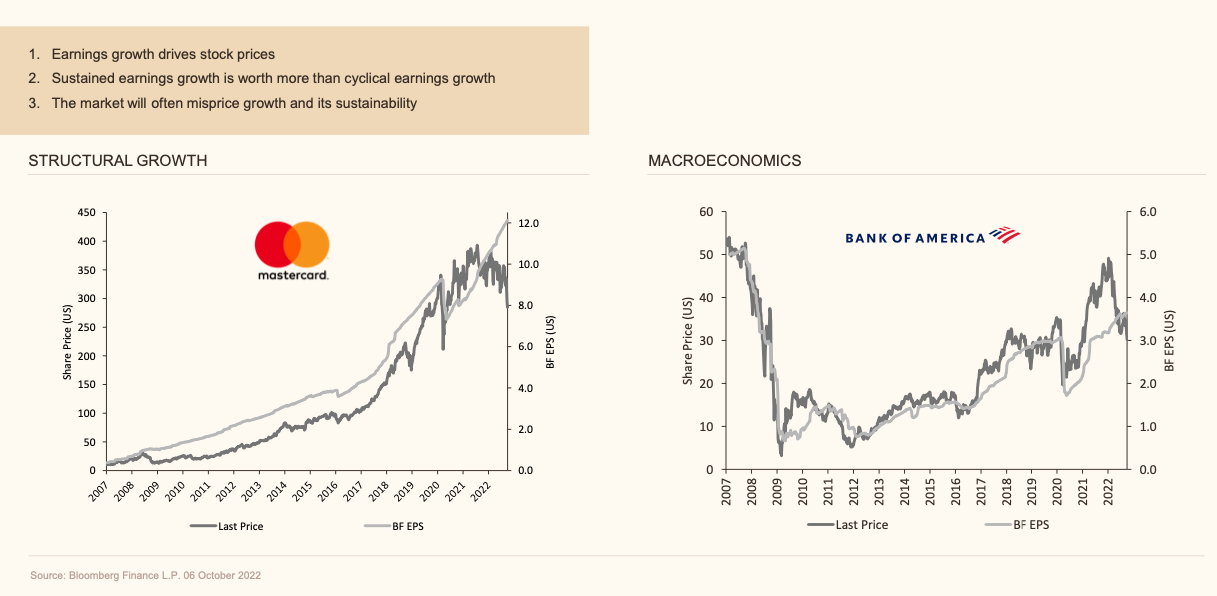
The light grey line is the blended forward earnings per share for this company, and the black line is their share prices, over the last 15 years. And you can clearly see that share prices follow earnings.
Secondly, we point out that Bank of America is a macroeconomic company. Its earnings are going up or down with the economy. At Munro Partners, we don't have a lot of value to add to this. We have a view of what the economy is going to do, but we don't have an edge. Our view is as good as other firm managers out there.
On the left-hand side, you have MasterCard. MasterCard is benefiting from the shift from physical cash to digital cash, so it's structural growth.
Its earnings have grown structurally over the last 15 years and the share price has followed its structural earnings growth, and this is what we're talking about.
The funny thing about MasterCard is everyone's known this for the last 10 years, yet the market can't price it in, and so that's the key point.
All that really matters
At Munro Partners, we're trying to identify the MasterCard situation repeatedly. And the reason why we do this, and the reason why we think this works, is because we think it's all that really matters.
We argue that if you go back over time and look at equity markets, it's not about going over or underweight sectors, or over or underweight countries.
Equity markets are made up of just a handful of exceptional companies, and thousands and thousands of mediocre ones.
On this chart, we're showing you an analysis done by a guy called Henry Bessembinder, who points out that if you looked at every company that ever listed over the last 90 years, it's 25,300 companies, yet only 4% of them make up the entire wealth for the US stock market over that time horizon.
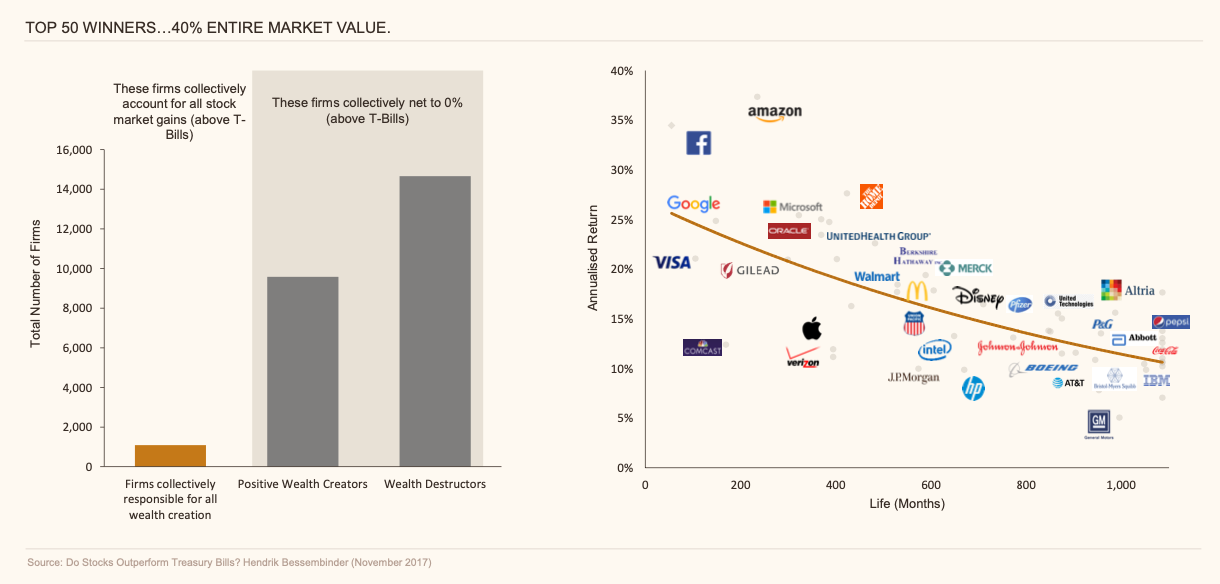
And if you look at just the top 50 of that 4%, that's 50 companies out of 25,000, they make up nearly 50% of the entire wealth of the US stock market over that time horizon.
So, equity investing is unashamedly a game of few winners and lots of losers.
On this side, on the right-hand side, we're showing you those top 50 companies. And if you look at those top 50 companies over time, macroeconomics has very little to do with it.
The reality is, if you look at their life along the bottom there, their annualised returns across the top, on the left there, it is always the big structural changes that create these companies.
Whether that's digitalisation that created Google, Facebook, and Amazon. Whether it's software that created Microsoft and Oracle, or even if you go further back, you can see big box retailing, Home Depot, Walmart, McDonald's and quick service restaurants, and Disney and entertainment.
It's fairly simple. Equity investing is not about identifying the economy, it's about identifying the big structural changes that are about to occur, and then identifying the winners.
At Munro Partners, our job is to occupy the top left-hand corner of this slide and to work out what's coming next.
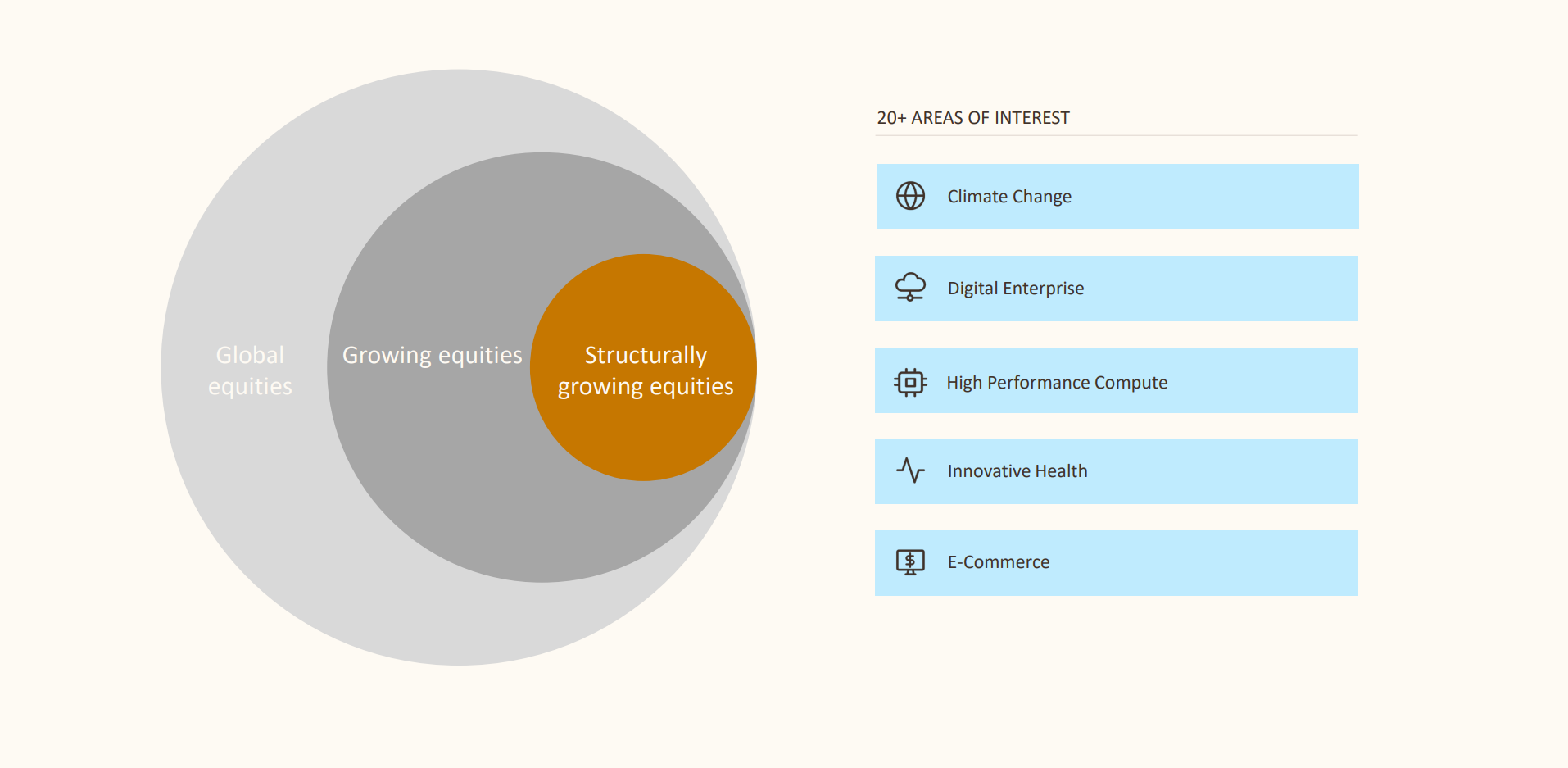
We do this by bringing our universe down to a very small group of structurally growing companies. Put simply, as we're showing you on this slide, there's literally over 35,000 companies in the world that are listed, and we have no hope of covering them all.
There's a whole bunch that profess to grow, but they're always growing because of those macroeconomic reasons, whether it's GDP going up or down, or interest rates going up or down. What we're interested in is these structurally growing equities, this smaller universe. We've got this down to 1,000 stocks, and we split it into these different areas of interest. So, climate change, or high-performance computing, or e-commerce, they're good places to look for those structurally growing areas.
These are good structural tailwinds in the economy today, and so clearly a good place to look for a structurally growing company. And what we're looking for are the companies that will execute best on these opportunities.
How we do that is to look at, and to really look at, what we've learned over the years about the qualities that define a great growth company. So, we've got our 1,000 companies and we've got our 20 different areas of interest.
Then we want to focus on the companies we think are going to do it best. And from our point of view, there are six characteristics of a great growth company.
- The first is that it can grow. Usually, revenue growth double GDP is what we're looking for.
- The second thing we're looking for is the ability to leverage that revenue growth.
- The third is that revenue growth is sustainable, or it has a long runway in front of it.
- Fourth, they've usually got good ESG characteristics.
- Fifth, they've normally got controlling shareholders, or highly aligned management.
- And sixth, they've usually got great customer perception.
If you go back over time, these six roles work very well for identifying great growth companies. Amazon had them, eBay didn't. Apple had them, Nokia and BlackBerry didn't. Even here in Australia, Macquarie Bank has them, National Australia Bank doesn't. These are the characteristics that you need to be a great growth company.
It usually means it's a good investment. Maybe not, because valuation is also important.
On the right-hand side, what we're asking the team to do is build an earnings model. That earnings model, bottom-up, proves that the earnings of this company can double over the next five years and that earnings model needs to mathematically prove that we can get the share price to double within five years.
That's essentially what we're looking for. In every area, we're looking for the structurally growing area, for the company we think can best execute that. And thirdly, for the one where the maths adds up to double the share price within the next five years, those are the companies that make it into the MUNRO CONCENTRATED GLOBAL GROWTH FUND.
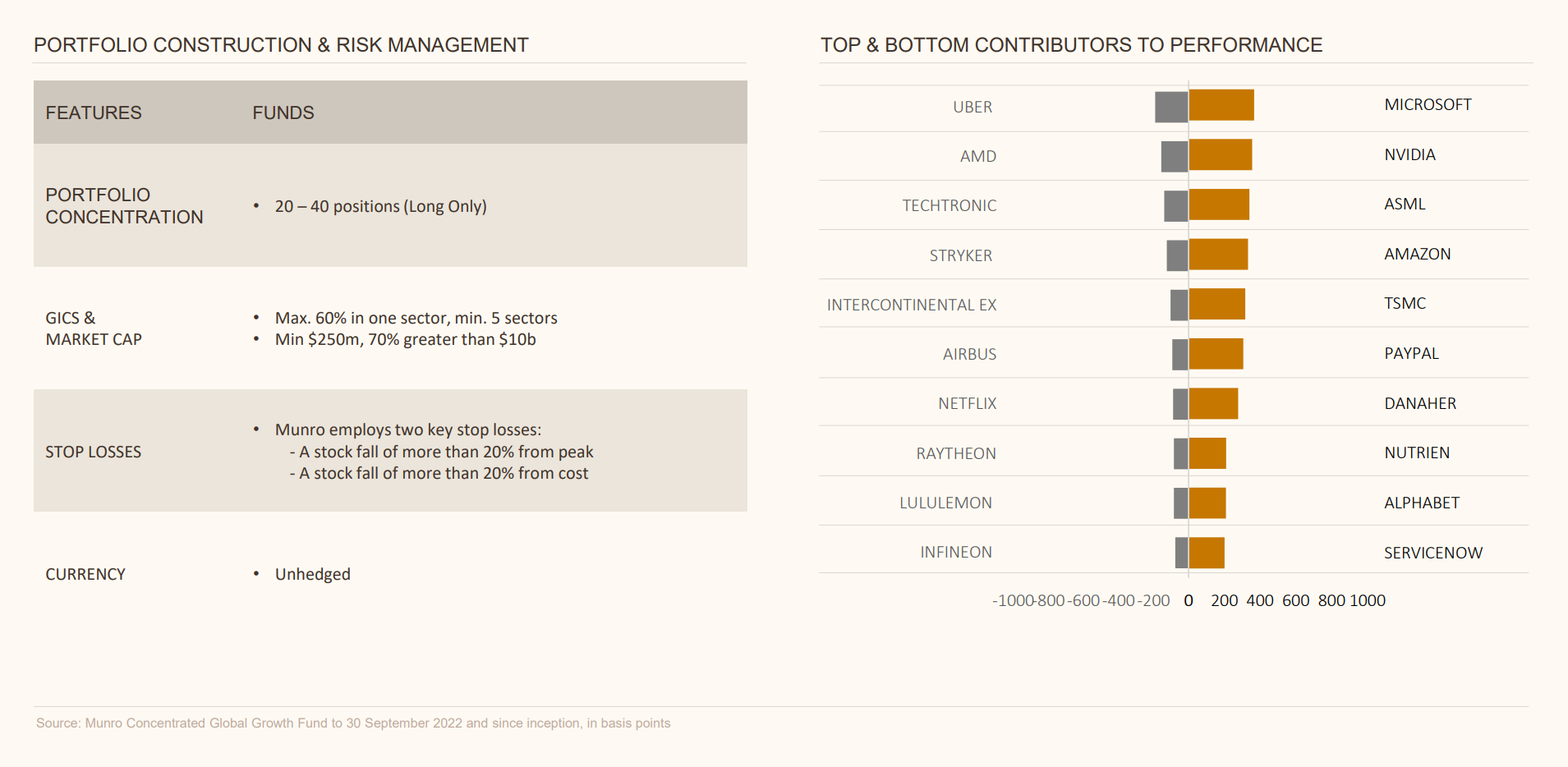
The last part of our process is clear, as I showed you on the first slide, if it's a game of very few winners and lots of losers, then we're clearly going to make mistakes, which is why risk management is incredibly important to what we do here at Munro.
This slide is showing you some of the rules that we put in place to keep our risk management in place, and so the first thing is we run 20 to 40 positions, so we do have a diversifiable portfolio.
Secondly, we have maximum position sizes of roughly 10%, and some restrictions around the sectors we can invest in.
Thirdly, and most importantly, we run formalised stop losses. Any company in the portfolio that falls 20% from cost, or 20% from peak is subject to a review. That review is designed not to force us to sell the company straight away, but merely to say, "Is the price telling us something that we might have missed? Should we review the investment case?"
We’ll review the investment case, and we often decide to keep the company, but in 30 days' time, if it's still triggering, we'll have to review it again. And in 30 days' time, if it's still triggering, we will review it again.
Inevitably, you work out that you've made a mistake. BlackBerry's not the smartphone, we know it's Apple, and so you end up selling your BlackBerry, and you buy Apple. Or eBay's not your e-commerce winner, it's Amazon.
What we're trying to do here is really minimise our mistakes, but also - most importantly - lead us towards those few big winners. And you can see this in action with the picture on the right.
On the right-hand side, we're showing you our top 10 winners since inception for the Munro Global Growth Fund, and on the left-hand side, you're seeing your top 10 losers, and this is the simple math that you need to think about, in basis points contribution for your fund.
Your winners should far outweigh your losers, i.e., you should find your winners and run them for long periods of time, because they are these exceptional growth companies, and you should eradicate your losers quickly, and this will ultimately lead you to double-digit returns that we're looking for from this product.
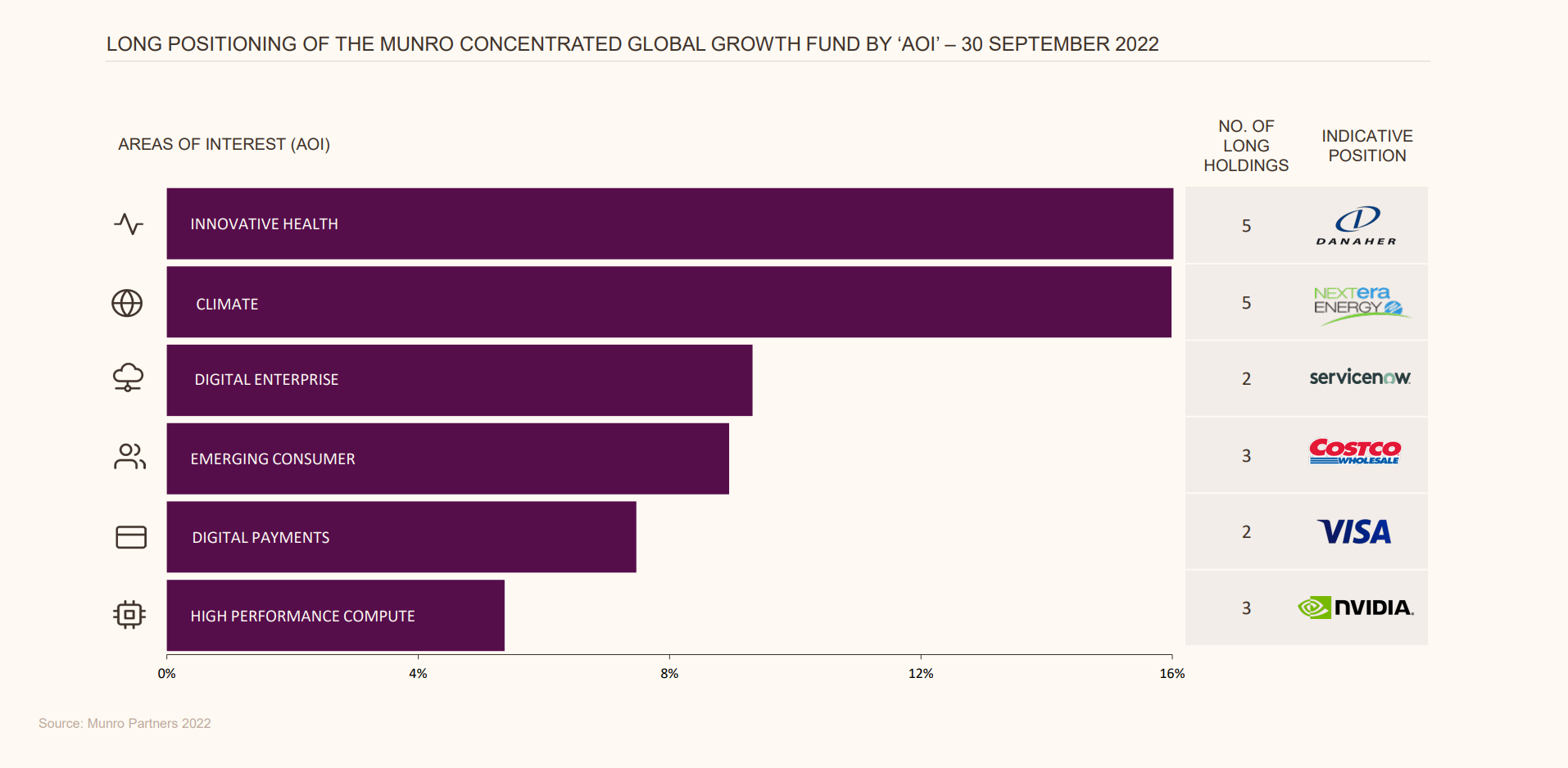
The last part of our process is really summed up on this last slide, so at the end of the day, what you're looking for is a range of different structural growth drivers, all of them with different idiosyncratic structural drivers, and those idiosyncratic drivers should lead you towards the companies that can grow their earnings as well.
And that earnings growth should lead to share price growth. What we're showing you here is the fund that was positioned at the end of September 2022, and you can see there that innovative health is the biggest area in their firm.
So these are healthcare companies that we think can grow regardless of the cycle. They make up roughly 16% of the fund. There are five companies there, and Danaher in bioprocessing is the biggest position there.
The second biggest area we like is climate at this point in time. We think the decarbonisation of the planet is going to accelerate. We've got 16% of the fund, with five holdings there, and the biggest position there is in NextEra Energy (NYSE: NEE) in the US.
Below that, we have digital enterprise, which is Cloud computing. Below that, emerging consumer, of which we like Costco (NASDAQ: COST), and a number of other names.
Below that are digital payments, which was the MasterCard idea I gave you earlier, and lastly, high-performance computing, which is semiconductors. These are the areas where we see strong structural tailwinds.
Those tailwinds should ultimately equal strong structural earnings growth for the companies that have best positioned themselves, and that earnings growth should ultimately leave you to strong structural share price growth and lead you towards the double-digit returns we're looking for.
So that, in short, is how we run the MUNRO CONCENTRATED GLOBAL GROWTH FUND. Lastly, we'll just please point you towards our website, and our materials for any more information you need to do with your personal situation, but also on the website are a bunch of videos that go into much more detail about some of those areas I talked about, and why we think they're such great investment opportunities for the future. Thanks very much for listening.



4 topics
4 stocks mentioned
2 funds mentioned


